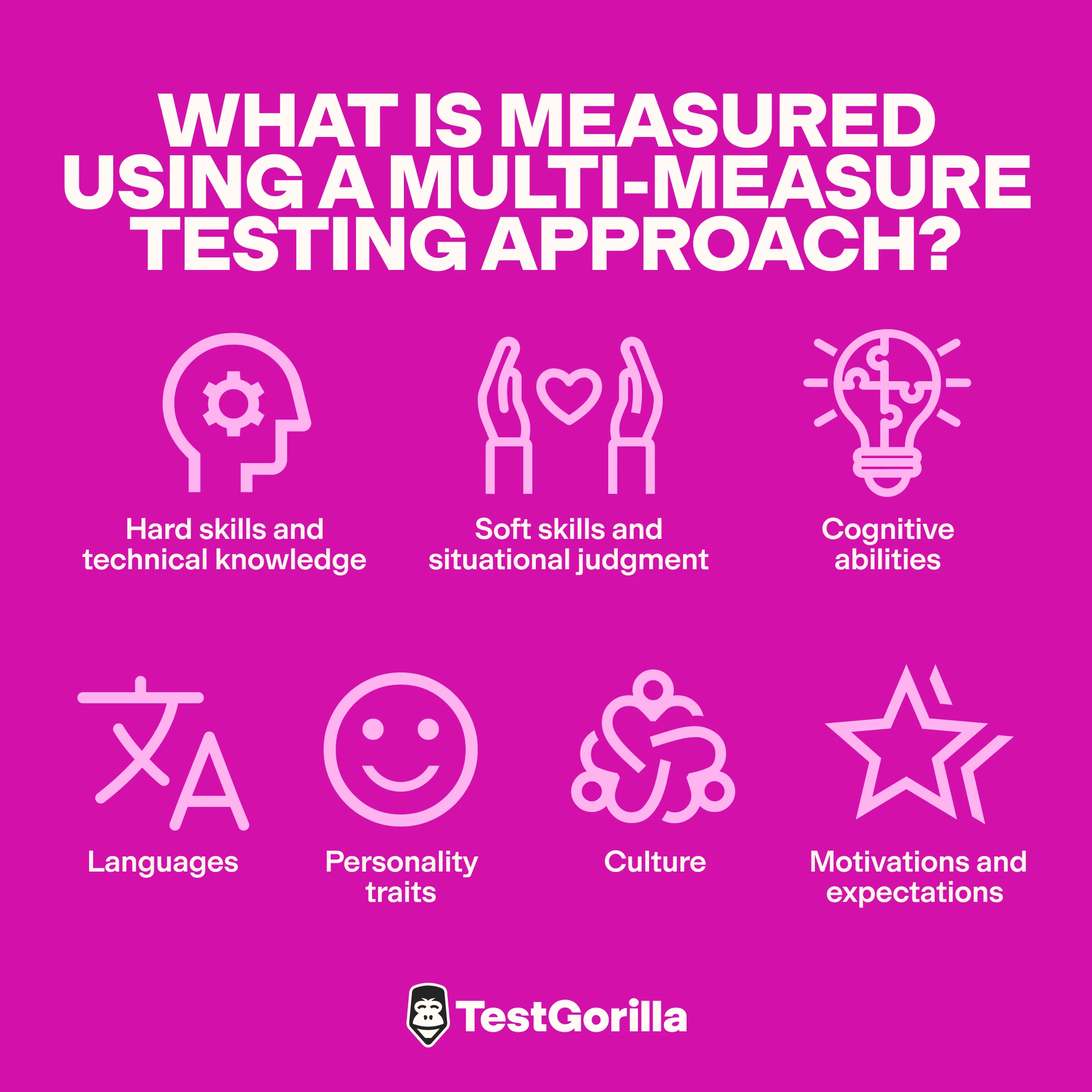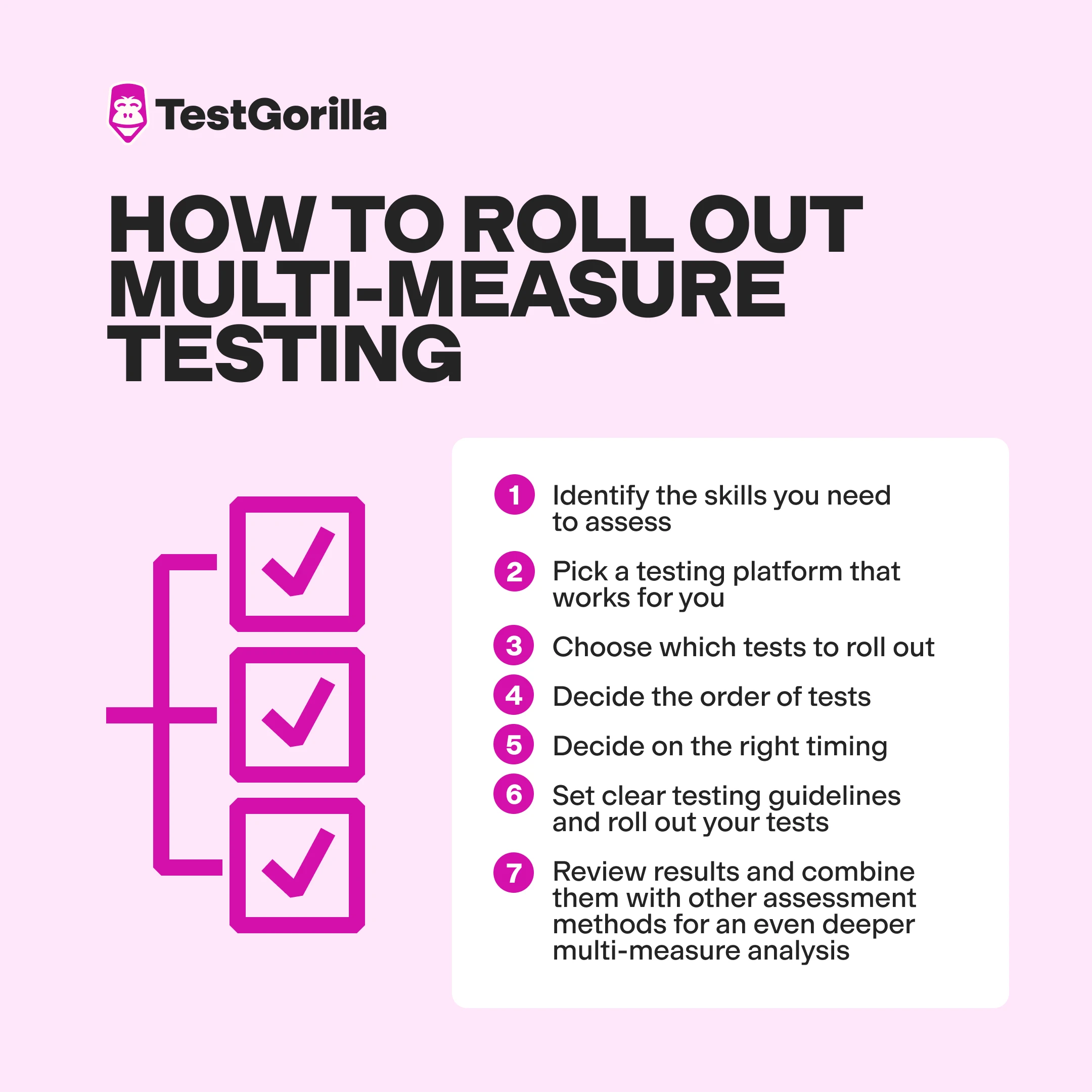A simple guide to multi-measure testing
We recently surveyed over 1,000 employers and found that 81% are now using skills-based hiring methods – assessing candidates for their real-life skills, not just their resumes. Since making the switch, employers have been able to hire faster, better, and cheaper.
That said, not everyone truly maximizes what skills-based hiring offers. Some employers are overly focused on hard skills, putting them at a disadvantage to those taking a more holistic approach with something called “multi-measure testing.”
Don’t know what this means? Don’t worry. You’ve come to the right place.
Below, we tell you what multi-measure testing is, why it’s the best way to do skills-based hiring, and how it can help you land the best candidates.
Table of contents
What is multi-measure testing?
Multi-measure testing is the process of assessing candidates on several factors, rather than just one type of skill. For instance, someone who uses multi-measure testing to hire a developer won’t just test their candidates’ tech skills. They might also test their attention to detail and communication abilities, plus how well they’ll gel with the company culture.
According to The State of Skills-Based Hiring 2024, 40% of employers that practice skills-based hiring are doing multi-measure testing. They see better results than the 60% who don't use it.
While you can assess candidates on all these factors using different tools like interviews, case studies, and hands-on tasks, the fastest and most objective multi-measure testing involves using online tests.
Multi-measure tests help you get a complete picture of a person. This way, you can hire someone who fits a job from every angle. This leads to fewer mis-hires and boosts performance, happiness, and retention rates.
Let’s look at some examples of what’s measured with this approach.
1. Hard skills and technical knowledge
Hard skills are the abilities and knowledge needed for a specific job. This can include everything from programming and data analytics to merchandising, operations, legal know-how, software proficiency, and even typing speed.
2. Soft skills and situational judgment
Soft skills encompass how candidates and employees interact with others and handle situations at work. Soft skills for office managers might include communication and multi-tasking. Meanwhile, soft skills for customer success managers likely entail leadership abilities and customer service skills.
3. Cognitive abilities
A candidate’s cognitive abilities involve how they think and process information. Here are some examples of cognitive skills.
Numerical reasoning entails working with numbers, analyzing graphs and charts, and interpreting data. This is one of the essential skills for financial analysts and traders, for instance.
Verbal reasoning and reading comprehension is the ability to understand language, process written materials, and derive accurate insights from this information. Recruiters hiring legal teams, HR managers, and project managers might look for this skill.
Attention to detail is crucial for easily spotting and fixing mistakes in written or visual information. This is non-negotiable in jobs like property management or editing.
Critical thinking and problem-solving are abilities that entail defining problems, analyzing them, and coming up with logical solutions. You’ll always find these on PR job descriptions, for instance.
Spatial reasoning involves correctly understanding the spatial relationships among objects in space. If you assess architect candidates, you’ll want to measure this skill.
4. Languages
Employers can also measure how fluent candidates are in the specific languages they need for a role. For instance, if you work closely with Spanish-speaking clients, some of your customer-facing roles might need someone who can read, write, and speak Spanish.
5. Personality traits
Traits refer to the thoughts, emotions, and behaviors that make up an individual’s personality – for example, analytical, empathetic, or meticulous. Employers measure traits to see if someone is a good addition to a particular role or team.
6. Culture
Measuring this means looking at how well a person's beliefs, values, and behaviors fit with the company's core values and culture. Will they get along with other employees, embrace the company's way of working, and add something positive to the workplace environment?
7. Motivations and expectations
An employer will measure a candidate’s motivation to understand what drives them to work and what they expect from their job and company when it comes to pay, benefits, and career development. This way, they can determine if a candidate will be happy and satisfied with what they can offer.
Why is multi-measure testing the ultimate hiring tool?
Here’s why multi-measure talent assessments are the best way to screen and assess candidates (and why employers who make it multi-measure see better results).
1. Makes a far better screening tool than resumes
Our research showed that 87% of employers experience problems using resumes in hiring. They don’t trust the accuracy, can’t determine which skills candidates actually have, and struggle to rank candidates using resumes.
Resumes tend to list a candidate’s qualifications and past experiences. Studies have shown that qualifications like college degrees have a weak correlation with future job performance.
Some might argue that today, many candidates list their skills on their resumes. While this may be true, can you simply take their word? Resumes don’t even enable you to verify hard skills – the easiest skills to define and measure. So, using resumes to evaluate soft skills, cognitive abilities, language fluency, and personality traits is out of the question.
Multi-measure talent assessments, on the other hand, offer a quick, scorable, and scalable way to evaluate candidates’ hard, soft, and cognitive skills, plus their personality traits. This enables you to make data-driven decisions and tap into highly skilled talent you may have written off because their resumes weren’t impressive enough.
2. Provides a more holistic view than individual tests do
Let’s say you’re hiring for a sales role. Relying solely on technical skills – such as product knowledge – isn’t good enough. You could end up with someone who knows your product inside and out but can’t pitch well or negotiate.
Similarly, looking solely for soft skills like communication or personality traits such as extroversion could mean you hire someone who’s unfamiliar with sales tactics.
By assessing candidates across multiple dimensions, you’ll get a well-rounded view of candidates’ capabilities and can avoid mis-hiring.
3. Increases predictive validity
The predictive validity of a tool looks at how accurately it can predict a candidate’s future performance in a job. In our survey, 94% of employers said skills-based hiring assessments – including cognitive ability tests, role-specific tests, assignments, and language tests – were more effective at predicting on-the-job success than resumes.
This is supported by long-term research by Frank Schimdt mentioned in the Harvard Business Review, which demonstrates that multi-measure testing is the most effective hiring selection practice.
That’s not all. Another more recent study by Harzer and colleagues examined how various assessment tools predicted job performance for 169 employees. They found that two specific personality and cognitive tests were good indicators of job performance.
The most interesting part? Combining these tests with additional assessments of “character strengths” (such as honesty, enjoying teamwork, or engaging in learning) significantly increased predictive validity.
So, while certain tests are effective even by themselves, using multiple assessment methods can help you dive deeper into candidates’ profiles to make better hiring decisions.
Multi-measure testing gives you the most accurate picture of a candidate’s strengths and weaknesses, and predicts their job performance using those measures. It’s research backed: It’s empirically proven that it offers the most effective and reliable way of assessing a person’s capabilities for a specific job.
– Kim Severinsen, Head of TestGorilla’s Science and Assessment Innovation CoE
4. Makes the hiring process fairer and more inclusive
A recent study by Sackett and colleagues discussed that while some employment testing tools – like cognitive ability tests – are very accurate at predicting job performance, individuals from different demographic groups can score substantially lower than others. The authors suggest using a combination of assessment tools for a fairer hiring process.
For example, non-native English speakers might score lower on certain tests due to a lack of familiarity with vocabulary or cultural nuances. Using multiple measures – like different test types – can combat this, giving candidates more opportunities to show their strengths.
5. Tests skills that are relevant today and tomorrow
The fast-moving pace of technology and the need for new technical skills have rendered four-year degrees obsolete. With employees constantly switching jobs and having to reskill, adaptability and other soft skills matter much more than qualifications and experience.
These qualities separate candidates who can learn and grow from those limited to what they already know. It’s no surprise, then, that 89% of employers told us that soft skills are more important now than five years ago.
In addition, we also saw a 15% jump in employers who believe cognitive tests are important in hiring – from 58% in 2022 to 73% in 2023. This further emphasizes the relevance of assessing not just hard skills but also soft skills and cognitive abilities in today’s hiring landscape.
What’s more – these qualities are expected to be as important (if not more) going into the future. The World Economic Forum’s latest Future of Jobs report showed that employers expect 44% of workplace skills to be disrupted in the next five years.
With this in mind, here are the skills and traits employers prioritized in 2023 and are expected to continue looking for in the coming years:
Analytical thinking
Creative thinking
Problem-solving
Technical literacy
Resilience
Flexibility
Agility
Motivation
Self-awareness
No single hiring technique can reliably capture a candidate’s capabilities in all these areas. Multi-measure talent assessments are best positioned to do this and help you hire candidates who can adapt to changing conditions.
6. Works well for remote hiring
Forbes expects over 90% of employers to be hiring remotely by 2025. This is where multi-measure talent assessments really shine.
Incorporating role-specific skills tests, personality tests, and culture-add assessments into your remote hiring campaign can help you learn more about your candidates before you interview them. This way, you can ask really pointed questions, probe their strengths and weaknesses better, and hire confidently.
7. Shortens the time to hire
Multi-measure tests can shorten your time to hire in the following ways.
Candidates can complete their online tests conveniently from anywhere they want – eliminating the need for in-person visits.
Most online tests are quick to complete and scored automatically, so you don’t have to do this manually.
You can learn about candidates from their tests rather than setting up separate time-consuming interviews (e.g., technical, competency-based interviews, and motivational interviews).
When you do interview them, you already have a good understanding of their abilities and can spend more time digging deeper into what you want to know.
Multi-measure tests provide objective scores to drive screening and hiring decisions and get everyone on the same page. This can prevent too many back-and-forth discussions.
Testing employees’ values, cultural expectations, and motivations lets you ensure you’re creating an offer that’s worthwhile to them. This avoids time wasted in last-minute negotiations around benefits, career trajectory, etc.
How to roll out multi-measure testing
Here’s a step-by-step guide to getting started with multi-measure testing.
Step 1: Identify the skills you need to assess
Start by considering which skills are essential to success in a particular job. Essential skills for marketing executives, for instance, might include hard skills like digital marketing, search engine optimization (SEO) knowledge, and familiarity with marketing analytics tools.
Additionally, think about the soft skills and traits needed for the role. For example, you’d want marketing executive candidates who are creative, empathetic, and good at communicating.
You can also speak to the hiring team, the future marketing executive’s team members, and department head to understand where the skills gaps are, what qualities they’re looking for, and what success looks like for the role.
Step 2: Pick a testing platform that works for you
Several testing platforms offer ready and robust online tests for your hiring process. Consider these factors before picking one:
First, check that it offers tests relevant to the skills you're hiring for and covers the multiple dimensions we’ve discussed.
Make sure that it’s user-friendly – both you and your candidates should find it easy to navigate.
Pick a platform that lets you combine multiple tests into one candidate-friendly talent assessment.
Also, consider the platform’s reliability and accuracy – it should consistently predict job performance. Read studies the platform has posted to back the science behind their tests.
Find a service that fits your budget but doesn't compromise on quality.
Lastly, read reviews and possibly request a demo to see how well it meets your needs.
Step 3: Choose which tests to roll out
Once you’ve picked your provider, choose the tests you want to roll out. They should be strongly linked to the specific skills and tasks needed in the job (check out our guide to job tasks analysis).
For hard skills, use role-specific technical tests – such as coding tests for developers. For soft skills, situational judgment tests can help you see how candidates would respond to real-world workplace scenarios. For example, a test could present a hypothetical situation where a deadline is missed and ask the candidate to choose their response from multiple options.
Depending on the role, you might want to use additional tests – such as language tests for customer service roles or typing speed tests for admin assistant roles.
Finally, consider putting all your candidates through personality and culture tests, which are important regardless of the role.
Step 4: Decide the order of tests
Taking tests requires deep thinking in a high-pressure, time-bound situation. That’s why the test order can impact candidates’ performance. Once you've decided which tests to roll out, think about the right order – for instance, most to least challenging. (Some testing platforms will let you pick the order, but some won’t.)
Step 5: Decide on the right timing
Figure out where these tests fit into your hiring process. You should assess candidates early. Ideally, tests should be the first step of the application process so you can use results to screen applicants. This way, you invest time interviewing only the most promising candidates who’ve already proven their skills.
Step 6: Set clear testing guidelines and roll out your tests
Help your candidates understand how the tests will be administered. For example, can they complete them online from the comfort of their homes, or will you have them take the tests in an assessment center setting? Will there be deadlines? How long will the tests take?
Ensure candidates know when and where to take the test and provide any other relevant instructions.
Step 7: Review results and combine them with other assessment methods for an even deeper multi-measure analysis
Once tests are completed, review candidate scores and take shortlisted candidates through the rest of your assessment process.
For instance, you could use structured interviews where you ask applicants a fixed set of questions.
In addition, you can ask candidates to share their portfolios, participate in case studies or group exercises, or even undergo a trial period.
4 mistakes to avoid when using multi-measure testing
When using multi-measure testing, avoid these common mistakes that can hamper the fairness and efficiency of your hiring process.
1. Skills overlap
Avoid rolling out more than one test that measures candidates on the same skill. Not only is this a waste of time and resources – it also might mean you miss out on testing other relevant skills that are crucial to your final decision.
For instance, there’s no point putting candidates through separate financial management and customer service tests if a restaurant manager test already covers both these skills.
To avoid a skills overlap, look carefully at the specific skills each test covers, and don't use tests that cover the same skill.
2. Inadequate test validation
Using tests that haven’t been properly validated can lead to inaccurate and unfair assessments. That’s why we recommend relying on reputed testing platforms rather than attempting to create your own tests or signing up for unreliable platforms.
3. Neglecting the candidate experience
There’s such a thing as too much testing. Overloading applicants with lengthy or overly complex tests can lead to fatigue, stress, and a negative candidate experience. This could lead to candidates opting out of the application process or having second thoughts about your company.
4. Misusing personality assessments
Avoid using personality tests in isolation when making hiring decisions. While they provide valuable insights into a person’s suitability for a team or role, over-reliance on test results can lead to dismissing skilled candidates who might’ve performed well in the role despite not matching a preconceived personality type.
You must interpret these results in the context of the candidate's complete profile, including their skills, cognitive abilities, and other competencies.
Find the perfect fit with multi-measure testing
A growing number of employers are now using a skills-based hiring approach. But not everyone’s doing it right.
The best way to screen and assess candidates is through multi-measure testing. This means testing candidates on their technical skills, soft skills, personality traits, cultural contributions, and more so you can make well-rounded and informed hiring decisions.
Identify the essential skills needed for a role, choose a diverse set of relevant tests, pick a reliable platform, and then roll out your multi-measure assessment as the first step of the application process. This way, you can make faster, better, and fairer screening decisions.
TestGorilla is a talent discovery platform with a huge test library of science-backed tests. If you’re ready to start multi-measure testing, our platform can be the perfect choice.
Related posts
You've scrolled this far
Why not try TestGorilla for free, and see what happens when you put skills first.
Latest posts
The best advice on pre-employment testing, in your inbox.
No spam. Unsubscribe at any time.

Hire the best. No bias. No stress.
Our screening tests identify the best candidates and make your hiring decisions faster, easier, and bias-free.
Free resources
This checklist covers key features you should look for when choosing a skills testing platform
This resource will help you develop an onboarding checklist for new hires.
How to assess your candidates' attention to detail.
Learn how to get human resources certified through HRCI or SHRM.
Learn how you can improve the level of talent at your company.
Learn how CapitalT reduced hiring bias with online skills assessments.
Learn how to make the resume process more efficient and more effective.
Improve your hiring strategy with these 7 critical recruitment metrics.
Learn how Sukhi decreased time spent reviewing resumes by 83%!
Hire more efficiently with these hacks that 99% of recruiters aren't using.
Make a business case for diversity and inclusion initiatives with this data.



















